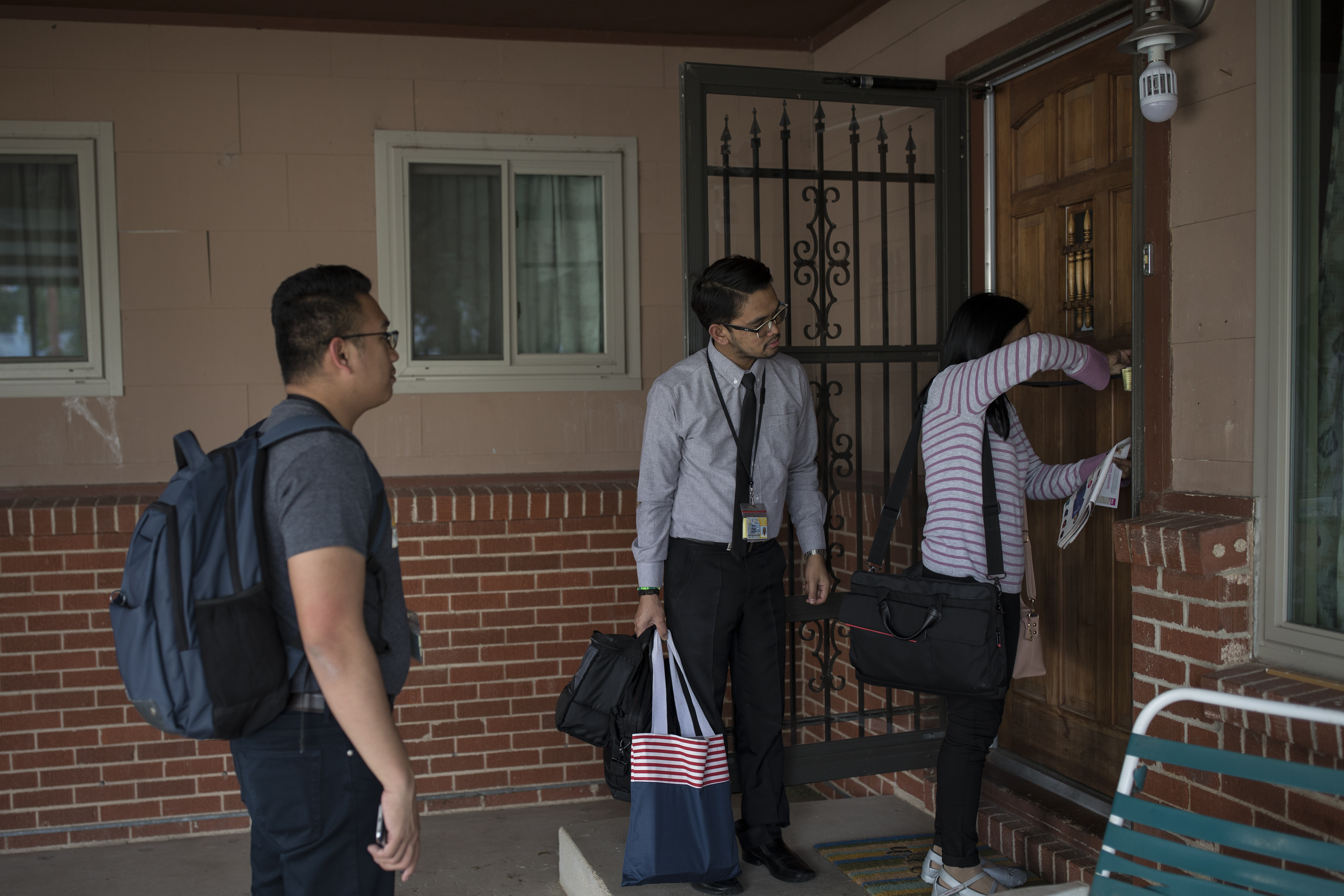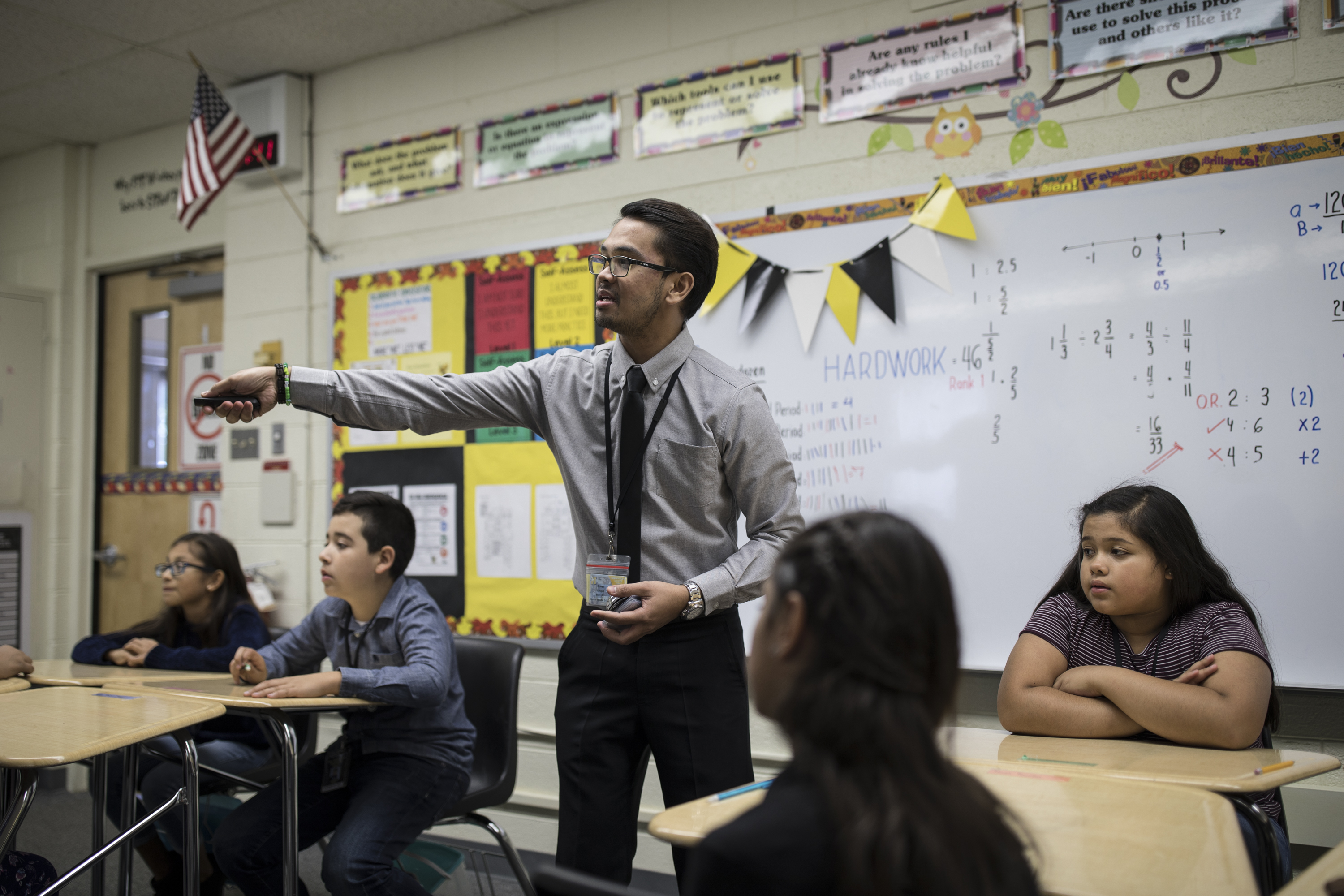HOBBS – The alarm rings at 3 a.m., and Ronell Mangilit is the first one up in a house shared with four fellow teachers. He prepares breakfast, writes up the day’s math lesson, and puts on a button-down shirt, a tie and crisply pressed slacks. Then it’s off to teach the children of New Mexican oil rig workers — arriving in his sixth-grade classroom by 7:20 sharp.
It’s a job no American wanted, but one the 30-year-old Filipino was willing to pay thousands of dollars to get.

Armed with a PhD in math education and a promise to a deceased brother, Mangilit borrowed the equivalent of a year’s salary in the Philippines — roughly $9,000. He used the money to pay multiple recruiting agencies, one of which helped him find the job at Heizer Middle School in Hobbs, where a statewide teacher shortage is made worse by the population growth that comes with a boom in the region’s oil fields.
He now owes that agency another $3,000 a year for three years. To make ends meet, he and his housemates converted the living room into a bedroom. Mangilit says his own sparsely furnished room has everything he needs: a bed, a table, an ironing board. A rosary shares a hook on the wall with his school ID.
“I would like to finance the college education of my niece,” he says, explaining that he hopes to pay his debts and start saving. “I am taking that as a responsibility, a fulfillment of the promise I made to my brother before he died. A little dramatic, but that’s it.”

More than 200 foreign teachers are taking a similar financial gamble to work in New Mexico public schools, where the teacher shortage has given rise to a desperate demand for math, science, special education and bilingual instructors.
Hobbs Municipal Schools alone has hired 39 teachers from the Philippines on J-1 “cultural exchange” visas. Lured by recruiters who charge a premium to work in one of more than a dozen New Mexico school districts, foreign teachers each shell out between $5,000 and $15,000 in recruitment fees, plus thousands of dollars in additional costs. They work in districts large and small, from Albuquerque, with its 91,000 students, to Questa, with its 378.
“You have a for-profit industry that has developed here,” says Eamonn Callan, a philosopher of education at Stanford University. “An obvious question is whether or not these prospective teachers from India, the Philippines and the like are getting a fair shake.”
The president of the Albuquerque Teachers Federation shares the skepticism.

“From what I have heard, some firms do right by the teachers, and some firms are totally exploiting these people,” says Ellen Bernstein. “I am worried about their living conditions and working conditions. Whether they have resources, transportation, mentorship, how much they are paying out of their paycheck.”
In dozens of interviews with recruiters, foreign teachers, school administrators, union leaders and others, Searchlight New Mexico found a system that lacks transparency and risks trapping teachers from developing nations for the life of their three-year visa. Many are so deeply indebted to recruiting agencies at home and in New Mexico that they have little choice but to stay put and pay what they owe.
“Let’s call it by its old name: indentured servitude,” says Ewa Krakowska, a union organizer for the National Educators Association in New Mexico. “It forces unrestricted compliance on the part of employees, because they want to stay here.”
Some job recruiters demand their fees in monthly installments while others ask for thousands of dollars at the outset. Either way, the teachers typically borrow hefty sums at high interest rates in their home countries to pay upfront costs. In New Mexico, they often don’t know their salary level until they get here.

Five weeks into the school year, Mangilit was wrestling with culture shock and homesickness; it’s his first time out of the Philippines, away from his family. But he says he knows he is one of the lucky ones; his credentials and experience earned him a top spot on the state’s salary schedule. Many of his lower-paid colleagues are struggling.
Ironically, most feel that this risky business is worth their while: New Mexico teacher salaries — which start at $36,180 and rank near the bottom in the nation — appear astronomical to Filipino teachers accustomed to earning $400 to $800 a month at home.
“The United States is the crown jewel for teachers coming [here],” says Colin Taylor, the former superintendent of San Jon Municipal Schools in eastern New Mexico who founded Presidio Teach, a recruitment agency that has placed dozens of teachers in New Mexico. “They entrust in us.”
Several teachers who spoke with Searchlight — on condition of anonymity out of concern for their jobs — say they felt misled by recruiters and didn’t understand the extent of the debt they were getting themselves into until they were here a year or more.
Among the cases Searchlight documented:
- A science teacher in Hobbs signed over 25 percent of his first-year $44,000 salary to Texas-based recruiter Gina Chiang of International Expert Resources (IER) under a contract that required him to pay $11,000 in one year. He spent the second year’s salary paying down debt he accrued in the Philippines to get to New Mexico. He lives in a crowded three-bedroom house with three other Filipino teachers, including one who brought his wife and two kids. “We are emotionally drained,” he says. “We are financially drained. Two years, and I still don’t have anything in my pockets.”
- A special ed math teacher in Clovis arrived from India at the start of the 2017 school year. “The one thing I am missing is transportation,” he says. A medical issue over the summer set him back financially. As a result, he still isn’t able to afford a car and is limited to walking to school and for groceries. He agreed to pay 15 percent of his roughly $55,000 salary — about $8,250 — to Presidio Teach every year for three years.
- A Hobbs math teacher paid $3,000 in fees to a placement agency in the Philippines and Chiang of IER. She also agreed to pay Chiang an additional $9,000 in “program costs” upon her arrival in New Mexico in 2017. “When you get here, you realize something is wrong,” she says. She had assumed her fees would cover the basics: airport pickup, temporary accommodations and help finding permanent housing. They didn’t. She had to rely on the kindness of Filipino and American teachers who stepped in to help. Chiang arrived later, she says, to set up a bank account to auto-debit $300 a month.
- A Roswell math teacher owes $15,000 — due in monthly installments — to her recruiter, Janice Bickert of Total Teaching Solutions International (TTSI), based in Ruidoso. This is despite the fact that the teacher handled most of the logistics on her own, she says — including finding the job, procuring a state license, airfare and housing. TTSI helped secure the J-1 visa sponsor.

Recruiters say they are paid to handle a complicated international exchange program. “I am a Cadillac service,” says Bickert, who adds that her contracts end should the teacher choose to return home. “I am not a one-year-and-done company.”
Taylor said, “I am not going to comment on arrangements we have with our teachers.”
Chiang adds: “We do a lot. Initially, we have to recruit the teacher into the program. Get their credential, their interview. Then the flight arrangement and housing, and we have to work with the school. We have to help with official documentations. Pretty much the whole time they are in the J-1 program we have to guide them.”
“There is nothing in the federal regulations to stop recruiters from charging fees,” says Dan Ewert of Cultural Vistas, a New York-based nonprofit organization that works with recruiters in New Mexico. It is an official U.S. State Department sponsor of J-1 “cultural exchange” visas.
“But we make sure to interview all the candidates,” he says, “and we have found there has been a lack of clarity on whether the teachers knew what they were getting into.”
Across the U.S., 2,876 J-1 visas were issued to teachers in 2017, up 140 percent from nearly 1,200 in 2010. In New Mexico, the State Department issued 166 J-1 visas to teachers between 2015 and 2017, compared to 70 in the prior three years.
The J-1 visa lasts three years and may be extended an additional two years. Unlike the H-1B guest worker program — coveted by foreign workers because it lasts six years, must be paid by the employer and is regarded as a stepping stone to U.S. residency — the J-1 is temporary, paid by the teacher and cannot be easily parlayed into permanent residency.
![]()
Even so, says Nathan Arnold, a U.S. State Department spokesperson, “The teacher exchange visitor program is a cultural opportunity for participants and host communities to take part in a mutually rewarding international exchange.”
Moreover, he adds, “Schools tell us that these teachers fill a critical need in areas where there is most often a shortage of U.S. teachers qualified to do the position.”
Mandy Carpenter stares down the teacher shortage every day as director of human resources in the Clovis Municipal School District, in eastern New Mexico’s dairy country. This year, she hired 11 teachers from the Philippines and India on J-1 “cultural exchange” visas.
“It really is the only way at this point,” she says. “We still have 15 openings and zero applicants. It’s not like there is a pool of candidates; there isn’t even a puddle of candidates. We have substitutes and retired teachers helping us out.”
![]() Experts chalk up the shortage to a variety of factors including low pay, mandated smaller class sizes and high attrition brought on by stressful teaching conditions. The proliferation of high-stakes testing has turned up the pressure on New Mexico teachers, whose professional evaluations are now tied to kids’ performance with little regard for extenuating circumstances.
Experts chalk up the shortage to a variety of factors including low pay, mandated smaller class sizes and high attrition brought on by stressful teaching conditions. The proliferation of high-stakes testing has turned up the pressure on New Mexico teachers, whose professional evaluations are now tied to kids’ performance with little regard for extenuating circumstances.
This school year, districts across New Mexico reported 740 teacher vacancies, up from 476 a year ago, according to data collected by New Mexico State University. Many of those slots are filled by long-term substitutes or uncertified instructors. In other words, nearly 53,500 students — roughly 15 percent of New Mexico’s student population — are being taught by an uncertified teacher this fall.
By contrast, the teachers from the Philippines are trained educators and have multiple years’ experience in the classroom.
“I do think (the shortage) points to problems and challenges with our teacher pay and the way teachers are treated,” says Paul Gessing, executive director of the fiscally conservative Rio Grande Foundation in Albuquerque. “The ever-changing bureaucracies, testing and the hoops these teachers have to jump through; districts are going overseas because Americans won’t do the job.”
District human resources directors say they are sensitive to concerns about foreign workers taking “American” jobs and often won’t take the recruiting agencies’ phone calls until summer. Several told Searchlight they go to great lengths to recruit U.S. candidates before looking farther afield.
Mireya Trujillo, director of human resources for the Roswell Independent School District, says she held 27 recruiting events last year but by midsummer she still had 50 openings. Only then did she give school principals a green light to interview teachers abroad, using Skype.
But several administrators also tell Searchlight that even after they engage with a recruiter, they don’t ask questions about the fees charged. Of 16 districts with J-1 teachers, only one said it worried about recruiter practices and tried to bypass them: Central Consolidated School District on the Navajo Nation.

That district relies on a network of Filipino teachers hired years ago on H-1B visas. They spread the word back home that the district was hiring, and it’s worked: Central Consolidated welcomed 19 Filipino teachers with J-1s this fall, using two visa sponsorship companies that charge about $1,500 per teacher and skipping the recruiting firms altogether.
“Teachers coming from the Philippines, they will do anything to have an experience teaching here,” says Leandro Venturin, a data coordinator and architect of CCSD’s policy. “If there are ways – just like we’re doing – not to charge them that (recruiting fee), I think that is a really good help, not just for the teachers but for their families back home.”
In Hobbs, even with its more than three dozen J-1 teachers, the school district still has 11 openings.
And at Heizer Middle, just two months into the school year, Mangilit is convinced he is doing an important job. That his students need him.
Soft-spoken but firm, he uses pop music, animated lessons and games to make fractions fun in a sixth-grade math class where half the students don’t know their multiplication tables — a basic third-grade skillset.
“The quality of his teaching is bar none,” says Kileen Smith, a seventh-grade math teacher who gave Mangilit a place to stay when he was first getting settled. “He has high expectations of his students.”
Mangilit is also attuned to the poverty of Hobbs’ south side. It’s an area ranked by the New Mexico Department of Health as the No. 2 spot in the state for concentrated risks to child well-being.
“I really want to give them what they deserve,” he says. “I am thinking: ‘What can I do as a teacher to make them love to go to school? To make them love math?’”
“I was a hardworking teacher in the Philippines, modesty aside,” he says. “But now I am more hardworking here because I see the need.”
Searchlight New Mexico is a nonprofit, nonpartisan news organization dedicated to investigative journalism. Read more of our stories on Raising New Mexico at projects.searchlightnm.com/
Reporter Lauren Villagran can be reached at lauren@searchlightnm.com.
Help Searchlight New Mexico continue to report the news that matters to you. Contribute at http://searchlightnm.com/support-investigative-reporting/
Other stories on this topic:
Recruiting agencies exploit education ties
Courts side with guest workers in exploitation schemes